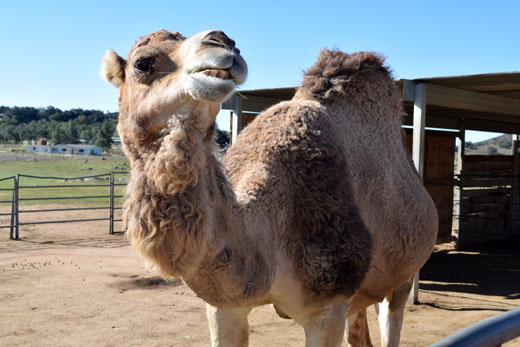
Story by Donald H. Harrison; photos by Shor M. Masori

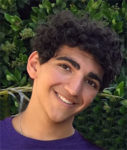
RAMONA, California – Camels know all about water conservation. Just ask Gil Riegler, the Canadian-born, Israeli-raised owner of the Oasis Camel Dairy located in this inland San Diego County town.
“Camels can go two weeks without drinking, lose 25 percent of their body weight in water, and then when they drink, it is just absorbed into their blood system,” Riegler says. Stopping before a female camel, he explains that “instead of sweating to cool down, she’ll let her body temperature rise, so that on a hot day her temperature will go up to 107 degrees, and it won’t even bother her. She won’t even sweat, because she doesn’t want to waste that water. If you touch a camel at night when it cools down, she is exuding all this heat, and the next morning when you touch her again, her body temperature is back to 98.6 degrees.”
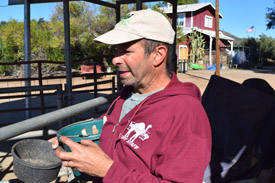
Furthermore, Riegler said, there is a membrane between the nostrils of the camel’s nose that is very wet. “When she breathes out, she has a cooling apparatus in her nose, so that when the humidity from her lungs condenses, it flows through that little tunnel back into her mouth, so that she doesn’t waste that humidity from her lungs.”
As opposed to horses and cows, which urinate lots of water, camels urinate a relatively small amount. This is another adaptation to the hot desert climates of Arabia, Egypt, and Israel where they are indigenous.
Camels have other genetic adaptations suitable for the desert, according to Riegler. For example, “they have three eyelids, instead of two like us. They have a clear one that comes across during a sand storm so that they can still keep walking around and eating. It (the third eyelid) keeps the sand from poking in.” Additionally, said Riegler, “they have valves in their ears that keep the sand from going in there.”
During the winter months, camels will have a heavy coat to protect themselves against the cold. Come summer, and they will shed their coats, which will then start growing out again in time for winter.
Before he opened the dairy, Riegler used to train animals to serve as entertainers or as companions to people with disabilities. He trained monkeys, birds, donkeys, and horses, and “then one day the director got a camel, and I just fell in love with the camel. The camel did so well with the kids. So I went out and bought baby camels of my own and that is how this whole thing started.”
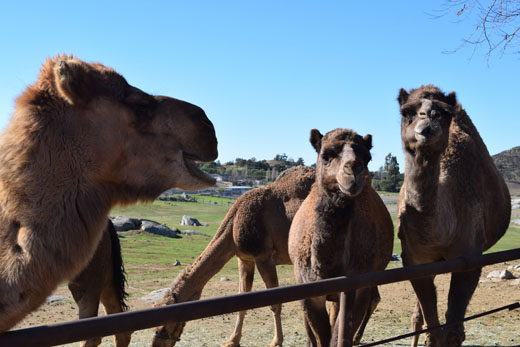
Walking down a line of camels, Riegler introduced them by name to visitors. “This is Cleopatra,” he said, “She was the first of the four baby camels I bought. Now she is 20 years old, and had a baby last year. Now she is retired.”
“We are not going to pet this next camel,” he instructed. “He is a bull camel, and you should never turn your back on a bull camel. They can go crazy during their rut season.” Riegler named the bull camel “Zohan” after the title character in the Adam Sandler movie, You Don’t Mess with the Zohan.
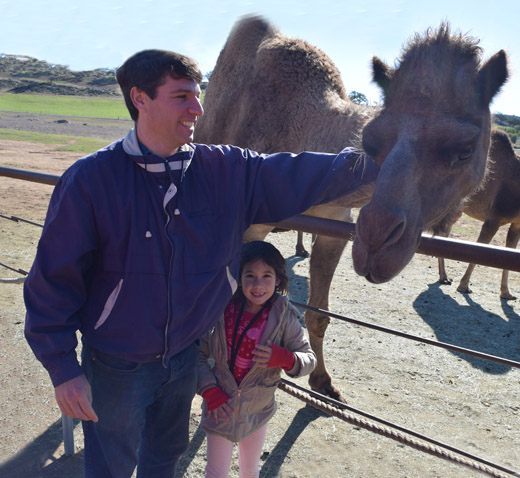
Next was Camelot, a gelding that had just returned from a visit to the Shadow Mountain Church, where he had lent his presence to a manger scene. December is a big month for the traveling exhibits offered by the Oasis Camel Dairy. “He does lots of stuff, he goes into buildings and TV stations. We have five camels that can do this, but he is the best. I got him as a gift from a friend of mine years ago.”
Another camel named Chip was a rescue camel. When he came to the Rieglers from a previous owner, “he had no hump, but he has one now. The people asked us how to take care of him. We tried to help them, but it didn’t work, so we bought him. As you can see, he is now super healthy, but he still had bad manners. He learned that he could bite people or hurt them. I have had him for between four and five years, and I haven’t been able to get him through that. I am hoping in the next five years that we can calm him down enough that he forgets his bad behaviors and becomes a gentle camel. I will work with him.”
Knuckles was pregnant, about 10 months into a normal 13-month pregnancy. Although he is not a veterinarian, Riegler knows how to assist a camel giving birth. The last birth at the dairy, he spread a big pile of sand out on the pasture, and the mother laid on it. Eventually, he could see the nose of the baby sticking out, and “I put my hand in there and pulled out the front two feet, and then (after the rest of the baby was born), I put the baby in front of her. It was real fun.”
Among other camels on the farm are Samson, who is the alpha male and “keeps talking all the time,” and Gallina, who is very gentle. “If a person is in a wheel chair, I will bring Gallina out and she will put her head in that person’s lap.” Another camel “Boo-Boo,” is named for the sidekick of the cartoon Yogi Bear character.
All the camels love to be fed apples on a stick, or “apple-pops,” as Riegler calls them. He asks visitors to withdraw the stick so that the camels won’t chomp on them after they have pulled off the apple treat.
Although Riegler calls his establishment a dairy, federal and state law limit what he can do with milk products. While the federal Food and Drug Administration has not certified domestic camel’s milk as safe for human consumption, “an even bigger problem is the State of California,” Riegler said. “They want us to have a Grade-A Dairy to milk just two camels. That would cost us between $200,000 and $300,000 to start.”
So, rather than make any products to drink or to eat, the Oasis Camel Dairy makes soaps and lotions for sale on the premises. It carries in its gift shop chocolate bars made from camel’s milk in Abu Dhabi, which have been deemed safe to import into the United States.
Riegler said there has been considerable research in Israel about the favorable impacts camel’s milk may have for children with autism, adding, however, that more research still needs to be done.
He noted that one-hump camels (dromedaries) are indigenous to Israel and the Middle East, whereas in the Gobi Desert of Asia, two-hump camels (Bactrians) are more prevalent. Another way to distinguish them is that the one-hump camels live in hot deserts, whereas the two-humped camels live in colder climates. Most of the research on camel’s milk has been done on that produced by a dromedary, not a Bactrian camel, he said.
Gil and his wife, Nancy, who formerly specialized in writing and performing avian shows at the Wild Animal Park, have several streams of income. They charge admission to the dairy, and sell products in the gift shop – including a T-shirt, which satirizes a bad review on Yelp that demeaned the Oasis Camel Dairy as “just a dirt patch with a couple of camels.” That part of the review facetiously is printed on T-shirt, generating at least 400 sales, Riegler said. “My wife says we should call that person and thank her!”
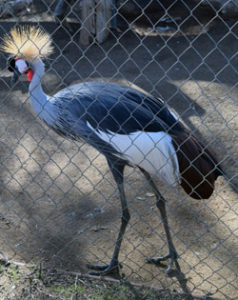
They also take their camels, sheep, and turkeys to various locations, creating portable petting zoos with the sheep. At the Del Mar Fair, they stage The Wild West Turkey Stampede on the infield. “I have a remote-control truck and I fill it up with treats and they run after it, and it’s a funny, goofy show,” Riegler commented. Caged near the turkeys is a female East African Crowned Crane, which seems to have an aversion to human males, but is very fond of Riegler’s wife, Nancy, and other women. “She loves my wife, but she hates me,” Riegler said. “Whenever I’m not home, she comes out and she is a good flier. If Nancy is in the tractor, she will fly over and sit in the bucket of it. The moment that she sees me, however, she’ll start pecking me. Otherwise, she is the nicest bird. She purrs when my wife pets her.”
General admission to the Oasis Camel Dairy’s open houses is $10. Camel rides are $12 for adults and $7 for children. Private tours may be arranged for $100 for a group of up to ten people, with an additional $8 per person for those in the group exceeding ten. Included in the admission price is the opportunity to feed an apple pop to a camel.
*
Harrison is editor of San Diego Jewish World. He may be contacted via donald.harrison@sdjewishworld.com